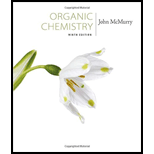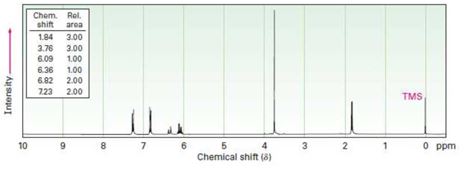
Study Guide with Student Solutions Manual for McMurry's Organic Chemistry, 9th
9th Edition
ISBN: 9781305082144
Author: John E. McMurry
Publisher: Cengage Learning
expand_more
expand_more
format_list_bulleted
Concept explainers
Textbook Question
Chapter 18.SE, Problem 54AP
Anethole, C10H12O, a major constituent of the oil of anise, has the 1H NMR spectrum shown. On oxidation with Na2Cr2O7, anethole yields p-methoxybenzoic acid. What is the structure of anethole? Assign all peaks in the NMR spectrum, and account for the observed splitting patterns.

Expert Solution & Answer
Trending nowThis is a popular solution!

Students have asked these similar questions
When talking about the acidity of carboxylic acids, is it the same thing to say higher or stronger acidity?
Using the following two half-reactions, determine the pH range in which $NO_2^-\ (aq)$ cannot be found as the predominant chemical species in water.* $NO_3^-(aq)+10H^+(aq)+8e^-\rightarrow NH_4^+(aq)+3H_2O(l),\ pE^{\circ}=14.88$* $NO_2^-(aq)+8H^+(aq)+6e^-\rightarrow NH_4^+(aq)+2H_2O(l),\ pE^{\circ}=15.08$
Indicate characteristics of oxodec acid.
Chapter 18 Solutions
Study Guide with Student Solutions Manual for McMurry's Organic Chemistry, 9th
Ch. 18.1 - Name the following ethers:Ch. 18.2 - Why do you suppose only symmetrical ethers are...Ch. 18.2 - How would you prepare the following ethers using a...Ch. 18.2 - Review the mechanism of oxymercuration shown in...Ch. 18.2 - How would you prepare the following ethers? Use...Ch. 18.2 - Prob. 6PCh. 18.3 - Prob. 7PCh. 18.3 - Write the mechanism of the acid-induced cleavage...Ch. 18.3 - Why are HI and HBr more effective than HCl in...Ch. 18.4 - What product would you expect from Claisen...
Ch. 18.5 - Prob. 11PCh. 18.6 - Predict the major product of each of the following...Ch. 18.6 - Prob. 13PCh. 18.6 - Predict the major product of the following...Ch. 18.7 - 15-Crown-5 and 12-crown-4 ethers complex Na+ and...Ch. 18.8 - Prob. 16PCh. 18.8 - 2-Butene-l-thiol is one component of skunk spray....Ch. 18.9 - The 1H NMR spectrum shown is that of a cyclic...Ch. 18.SE - Give IUPAC names for the following compounds...Ch. 18.SE - Show the product, including stereochemistry, that...Ch. 18.SE - Prob. 21VCCh. 18.SE - Treatment of the following alkene with a...Ch. 18.SE - Prob. 23MPCh. 18.SE - Prob. 24MPCh. 18.SE - Predict the product(s) and provide the mechanism...Ch. 18.SE - The alkoxymercuration of alkenes involves the...Ch. 18.SE - Predict the product(s) and provide the mechanism...Ch. 18.SE - Predict the product(s) and provide the mechanism...Ch. 18.SE - Prob. 29MPCh. 18.SE - Ethers undergo an acid-catalyzed cleavage reaction...Ch. 18.SE - Treatment of 1, 1-diphenyl-l, 2-epoxyethane with...Ch. 18.SE - Fluoxetine, a heavily prescribed antidepressant...Ch. 18.SE - When 2-methyl-2, 5-pentanediol is treated with...Ch. 18.SE - Prob. 34MPCh. 18.SE - Prob. 35MPCh. 18.SE - Aldehydes and ketones undergo acid-catalyzed...Ch. 18.SE - Propose a mechanism to account for the following...Ch. 18.SE - Prob. 38APCh. 18.SE - Prob. 39APCh. 18.SE - How would you prepare the following ethers?Ch. 18.SE - Prob. 41APCh. 18.SE - tert-Butyl ethers can be prepared by the reaction...Ch. 18.SE - Treatment of trans-2-chlorocyclohexanol with NaOH...Ch. 18.SE - Predict the products of the following ether...Ch. 18.SE - Prob. 45APCh. 18.SE - Prob. 46APCh. 18.SE - Write the mechanism of the hydrolysis of cis-5,...Ch. 18.SE - Prob. 48APCh. 18.SE - Acid-catalyzed hydrolysis of a 1,...Ch. 18.SE - Prob. 50APCh. 18.SE - Epoxides are reduced by treatment with lithium...Ch. 18.SE - Prob. 52APCh. 18.SE - The red fox (Vulpes vulpes) uses a chemical...Ch. 18.SE - Anethole, C10H12O, a major constituent of the oil...Ch. 18.SE - Propose structures for compounds that have the...Ch. 18.SE - Prob. 56GPCh. 18.SE - How would you synthesize anethole (Problem 18-54)...Ch. 18.SE - How could you prepare benzyl phenyl ether from...Ch. 18.SE - Meerwein's reagent, triethyloxonium...Ch. 18.SE - Prob. 60GPCh. 18.SE - Prob. 61GPCh. 18.SE - The Zeisel method is an old analytical procedure...Ch. 18.SE - Prob. 63GPCh. 18.SE - Prob. 64GPCh. 18.SE - Prob. 65GPCh. 18.SE - Identify the reagents a-e in the following scheme:Ch. 18.SE - Propose structures for compounds that have the...Ch. 18.SE - Prob. 68GPCh. 18.SE - Prob. 69GPCh. 18.SE - Predict the product(s) if the starting materials...
Knowledge Booster
Learn more about
Need a deep-dive on the concept behind this application? Look no further. Learn more about this topic, chemistry and related others by exploring similar questions and additional content below.Similar questions
- What is the final product when hexanedioic acid reacts with 1º PCl5 and 2º NH3.arrow_forwardWhat is the final product when D-galactose reacts with hydroxylamine?arrow_forwardIndicate the formula of the product obtained by reacting methyl 5-chloro-5-oxopentanoate with 1 mole of 4-penten-1-ylmagnesium bromide.arrow_forward
- The temperature on a sample of pure X held at 1.25 atm and -54. °C is increased until the sample boils. The temperature is then held constant and the pressure is decreased by 0.42 atm. On the phase diagram below draw a path that shows this set of changes. pressure (atm) 2 0 0 200 400 temperature (K) Xarrow_forwardQUESTION: Answer Question 5: 'Calculating standard error of regression' STEP 1 by filling in all the empty green boxes *The values are all provided in the photo attached*arrow_forwardpressure (atm) 3 The pressure on a sample of pure X held at 47. °C and 0.88 atm is increased until the sample condenses. The pressure is then held constant and the temperature is decreased by 82. °C. On the phase diagram below draw a path that shows this set of changes. 0 0 200 temperature (K) 400 аarrow_forward
arrow_back_ios
SEE MORE QUESTIONS
arrow_forward_ios
Recommended textbooks for you

 Organic ChemistryChemistryISBN:9781305580350Author:William H. Brown, Brent L. Iverson, Eric Anslyn, Christopher S. FootePublisher:Cengage Learning
Organic ChemistryChemistryISBN:9781305580350Author:William H. Brown, Brent L. Iverson, Eric Anslyn, Christopher S. FootePublisher:Cengage Learning


Organic Chemistry
Chemistry
ISBN:9781305580350
Author:William H. Brown, Brent L. Iverson, Eric Anslyn, Christopher S. Foote
Publisher:Cengage Learning
IR Spectroscopy; Author: Professor Dave Explains;https://www.youtube.com/watch?v=_TmevMf-Zgs;License: Standard YouTube License, CC-BY